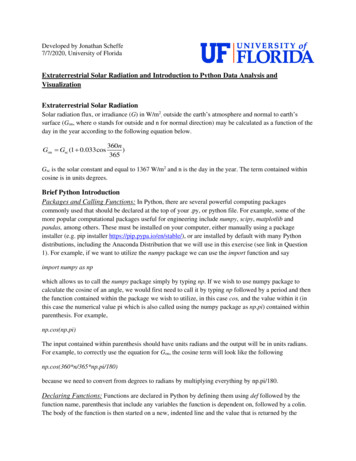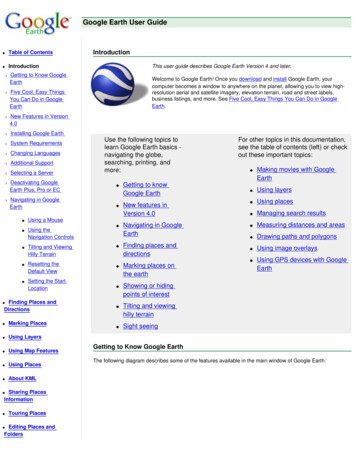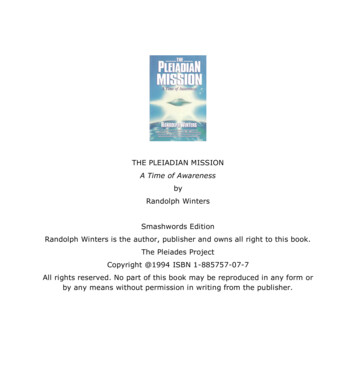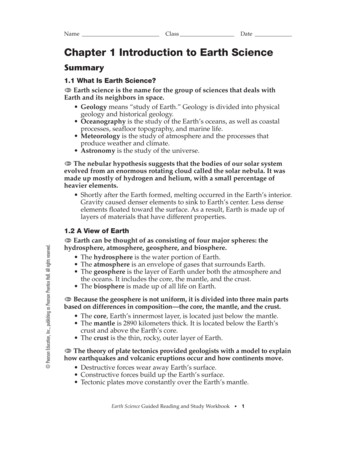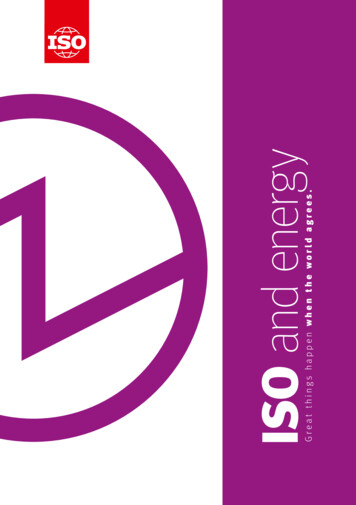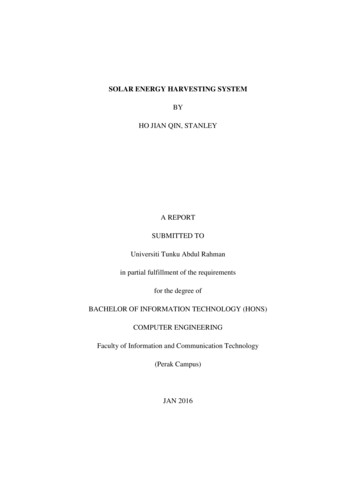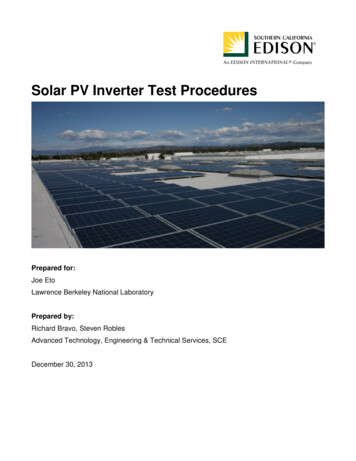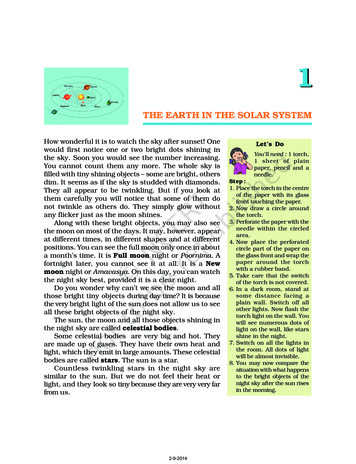
Transcription
1THE EARTH IN THE SOLAR SYSTEMHow wonderful it is to watch the sky after sunset! Onewould first notice one or two bright dots shining inthe sky. Soon you would see the number increasing.You cannot count them any more. The whole sky isfilled with tiny shining objects – some are bright, othersdim. It seems as if the sky is studded with diamonds.They all appear to be twinkling. But if you look atthem carefully you will notice that some of them donot twinkle as others do. They simply glow withoutany flicker just as the moon shines.Along with these bright objects, you may also seethe moon on most of the days. It may, however, appearat different times, in different shapes and at differentpositions. You can see the full moon only once in abouta month’s time. It is Full moon night or Poornima. Afortnight later, you cannot see it at all. It is a Newmoon night or Amavasya. On this day, you can watchthe night sky best, provided it is a clear night.Do you wonder why can’t we see the moon and allthose bright tiny objects during day time? It is becausethe very bright light of the sun does not allow us to seeall these bright objects of the night sky.The sun, the moon and all those objects shining inthe night sky are called celestial bodies.Some celestial bodies are very big and hot. Theyare made up of gases. They have their own heat andlight, which they emit in large amounts. These celestialbodies are called stars. The sun is a star.Countless twinkling stars in the night sky aresimilar to the sun. But we do not feel their heat orlight, and they look so tiny because they are very very farfrom us.2-9-2014Let’s DoYou’ll need : 1 torch,1 sheet of plainpaper, pencil and aneedle.Step :1. Place the torch in the centreof the paper with its glassfront touching the paper.2. Now draw a circle aroundthe torch.3. Perforate the paper with theneedle within the circledarea.4. Now place the perforatedcircle part of the paper onthe glass front and wrap thepaper around the torchwith a rubber band.5. Take care that the switchof the torch is not covered.6. In a dark room, stand atsome distance facing aplain wall. Switch off allother lights. Now flash thetorch light on the wall. Youwill see numerous dots oflight on the wall, like starsshine in the night.7. Switch on all the lights inthe room. All dots of lightwill be almost invisible.8. You may now compare thesituation with what happensto the bright objects of thenight sky after the sun risesin the morning.
Figure 1.1 : Saptarishi and theNorth StarInteresting FactJupiter, Saturn andUranus have ringsaround them. Theseare belts of small debris.These rings may beseen from the earthwith the help of powerfultelescopes.You must have noticed that allobjects look smaller when seen from adistance. How small an aeroplane lookswhen it is flying at a great height!While watching the night sky, youmay notice various patterns formed bydifferent groups of stars. These arecalled constellations. Ursa Major orBig Bear is one such constellation. Oneof the most easily recognisableconstellation is the small bear orSaptarishi (Sapta-seven, rishi-sages). Itis a group of seven stars (Figure 1.1)that forms a part of the large Ursa MajorConstellation. Ask someone elder inyour family or neighbourhood to showyou more stars, planets andconstellations in the sky.In ancient times, people used todetermine directions during the nightwith the help of stars. The North starindicates the north direction. It is alsocalled the Pole Star. It always remainsin the same position in the sky. We canlocate the position of the Pole Star withthe help of the Saptarishi. Look at Figure 1.1. Youwill notice that, if an imaginary line is drawn joiningthe pointer stars and extended further, it will point tothe Pole Star.Some celestial bodies do not have their own heatand light. They are lit by the light of the stars. Suchbodies are called planets. The word ‘planet’ comes fromthe Greek word “Planetai” which means ‘wanderers’.The earth on which we live is a planet. It gets all itsheat and light from the sun, which is our nearest star.If we look at the earth from a great distance, say themoon, it will appear to be shining just as the moon.The moon that we see in the sky is a satellite. It is acompanion of our earth and moves round it. Like ourearth, there are eight other planets that get heat andlight from the sun. Some of them have their moons too.THESOLAR SYSTEMThe sun, eight planets, satellites and some othercelestial bodies known as asteroids and meteoroids2THE EARTH : OUR HABITAT2-9-2014
THE EARTH IN THE SOLAR SYSTEM32-9-2014Figure 1.2 : The Solar SystemInner planets - very close to the sun. They are made upof rocks.1. MERCURY - One orbit around sun - 88 days,One spin on axis - 59 days.2. VENUS- One orbit around sun - 255 days.One spin on axis - 243 days3. EARTH- One orbit around sun - 365 days.One spin on axis - 1 dayNumber of moons - 14. MARS- One orbit around sun - 687 daysOne spin on axis - 1 day,number of moons - 028. NEPTUNE - One orbit around sun - 164 years.One spin on axis-16 hours 7minutes, number of moons - 8.Outer Planets - Very-very far from the sun and are huge planets made up of gases and liquids.5. JUPITER - One orbit around sun - 11 years, 11months about 12 years. One spin onaxis - 9 hours, 56 minutes, number ofmoons - 166. SATURN - One orbit around sun - 29 years, 5months. One spin on axis - 10 hours 40minutes, number of moons - about 18.7. URANUS - One orbit around sun - 84 years. Onespin around axis - 17 hours 14 minutes,number of moons - about 17.
Do you know?‘Sol’ in Romanmythology isthe ‘Sungod’.‘Solar’ means‘related to the sun’. Thefamily of the sun is,therefore, called the solarsystem. Write down asmany words using the wordsolar on your own as youcan.Word OriginMany words usedin a language mayhave been takenfrom some other language.Geography, for example, isan English word. It has itsorigin in Greek, whichrelates to the descriptionof the earth. It is made oftwo Greek words, ‘ge’meaning’ ‘earth’ and‘graphia’ meaning ‘writing’.Find out more about theearth.Do you know?Humans havealwaysbeenfascinated gazingat the night sky. Those whostudy the celestial bodiesand their movements arecalledastronomers.Aryabhatta was a famousastronomer of ancientIndia. Today, astronomersall over the world are busyexploring the universe.form the solar system. We often call it a solar family,with the sun as its Head.The SunThe sun is in the centre of the solar system. It is hugeand made up of extremely hot gases. It provides thepulling force that binds the solar system. The sun isthe ultimate source of heat and light for the solarsystem. But that tremendous heat is not felt so muchby us because despite being our nearest star, it is faraway from us. The sun is about 150 million km awayfrom the earth.PlanetsThere are eight planets in our solar system. In order oftheir distance from the sun, they are: Mercury,Venus, Earth, Mars, Jupiter, Saturn, Uranus andNeptune.An easy way to memorise the name of the planets inorder of their distance from the sun is:MY VERY EFFICIENT MOTHER JUST SERVED US NUTS.All the eight planets of the solar system movearound the sun in fixed paths. These paths areelongated. They are called orbits. Mercury is nearestto the sun. It takes only about 88 days to completeone round along its orbit. Venus is considered as‘Earth’s-twin’ because its size and shape are very muchsimilar to that of the earth.T ill recently (August 2006), Pluto was alsoconsidered a planet. However, in a meeting of theInternational Astronomical Union, a decision wastaken that Pluto like other celestial objects (Ceres, 2003UB 313 ) discovered in recent past may be called‘dwarf planets.”The EarthThe earth is the third nearest planet to the sun. Insize, it is the fifth largest planet. It is slightly flattenedat the poles. That is why, its shape is described as aGeoid. Geoid means an earth-like shape.4THE EARTH : OUR HABITAT2-9-2014
Conditions favourable to support life are probablyfound only on the earth. The earth is neither too hotnor too cold. It has water and air, which are veryessential for our survival. The air has life-supportinggases like oxygen. Because of these reasons, the earthis a unique planet in the solar system.From the outer space, the earth appears bluebecause its two-thirds surface is covered by water. Itis, therefore, called a blue planet.Do you know?Light travels atthe speed ofabout 300,000km per second.Yet, even with this speed,the light of the sun takesabout eight minutes toreach the earth.The MoonOur earth has only onesatellite, that is, themoon. Its diametre isonly one-quarter that ofthe earth. It appears sobig because it is nearer toour planet than othercelestial bodies. It isabout 3,84,400 km awayfrom us. Now you cancompare the distance of Figure 1.3 : The moon as seen fromthe spacethe earth from the sunand that from the moon.The moon moves around the earth in about 27 days.It takes exactly the same time to complete one spin. Asa result, only one side of the moon is visible to us onthe earth.The moon does not have conditions favourable forlife. It has neither water nor air. It has mountains,Rocket launchRocket falls back to the EarthSatellite enters orbitFigure 1.4 : Human-made SatelliteInteresting FactNeil Armstrong wasthe first man tostep on the surfaceof the moon on 21 July1969. Find out whetherany Indian has landed onthe moon?A Satellite is a celestialbody that moves aroundthe planets in the sameway as the planets movearound the sun.A Human-made Satelliteis an artificial body. It isdesigned by scientists togather information aboutthe universe or forcommunication. It iscarried by a rocket andplaced in the orbit aroundthe earth.Some of the Indiansatellites in space are INSAT,IRS, EDUSAT, etc.? What do animals andplants require in orderto grow and survive?5THE EARTH IN THE SOLAR SYSTEM2-9-2014
plains and depressions on its surface. These castshadows on the moon’s surface. Look at the full moonand observe these shadows.AsteroidsFigure 1.5 : AsteroidApart from the stars, planets and satellites, there arenumerous tiny bodies which also move around thesun. These bodies are called asteroids. They are foundbetween the orbits of Mars and Jupiter (Figure 1.2).Scientists are of the view that asteroids are parts of aplanet which exploded many years back.MeteoroidsThe small pieces of rocks which move around the sunare called meteoroids. Sometimes these meteoroidscome near the earth and tend to drop upon it. Duringthis process due to friction with the air they get heatedup and burn. It causes a flash of light. Sometimes, ameteor without being completely burnt, falls on theearth and creates a hollow.Do you see a whitish broad band, like a whiteglowing path across the sky on a clear starry night? Itis a cluster of millions of stars. This band is the MilkyWay galaxy (Figure 1.6). Our solar system is a part ofthis galaxy. In ancient India, it was imagined to be ariver of light flowing in the sky. Thus, it was namedAkash Ganga. A galaxy is a huge system of billions ofstars, and clouds of dust and gases. There are millionsof such galaxies that make the Universe. It is difficultto imagine how big the universe is. Scientists are stilltrying to find out more and more about it. We are notcertain about its size but we knowthat all of us – you and I belong tothis universe.Figure 1.6 : Milky Way6THE EARTH : OUR HABITAT2-9-2014
Can you relate yourself withthe universe now? You are onthe earth and the earth is apart of the solar system. Oursolar system is a part of theMilky Way galaxy which is partof the universe. Think about theuniverse, and the fact that itcontains millions of suchgalaxies. How do you fit in thepicture?1. Answer the following questions briefly.(a)How does a planet differ from a star?(b)What is meant by the ‘Solar System’?(c)Name all the planets according to their distance from the sun.(d)Why is the Earth called a unique planet?(e)Why do we see only one side of the moon always?(f)What is the Universe ?2. Tick the correct answer.(a)The planet known as the “Earth’s Twin” is(i) Jupiter(b)(ii) Earth(iii) MercuryAll the planets move around the sun in a(i) Circular path(d)(iii) VenusWhich is the third nearest planet to the sun ?(i) Venus(c)(ii) Saturn(ii) Rectangular path(iii) Elongated pathThe Pole Star indicates the direction to the(i) South(ii) North(iii) East7THE EARTH IN THE SOLAR SYSTEM2-9-2014
(e)Asteroids are found between the orbits of(i) Saturn and Jupiter(ii) Mars and Jupiter(iii) The Earth and Mars3. Fill in the blanks.(a)A group of forming various patterns is called a .(b)A huge system of stars is called .(c)is the closest celestial body to our earth.(d)is the third nearest planet to the sun.(e)Planets do not have their own and .1.Prepare a chart of the solar system.2.During a vacation visit a planetarium and describe your experiencein the class.3.Organise a quiz contest on the earth and the solar system.1.The sun is commonly known as Soorya or Sooraj in Hindi, Find out itsname in different languages of our country. Take help of your friends,teachers and neighbours.2.You might have heard that people make human chains and run for worldpeace etc. You can also make a human solar system and run for fun.Step 1:Step 2:All children of your class can play this game. Assemble in a bighall or on a playground.Now draw 8 circles on the ground as shown in the figure drawn onthe opposite page.Use a 5-metre long rope. Mark at every half a metre with a chalk orink. Place a small nail to mark the centre. Now hold one end ofthe rope at the central position. Ask your friend to hold a chalkat the ½ metre mark and move around the nail holding rope andchalk together on the ground.You have drawn one circle just as you do on paper using a compassand a pencil. Draw other circles in the same manner.Step 3:Prepare 10 placards. Name them as Sun., Moon, Mercury, Venus,Earth, Mars, Jupiter, Saturn, Uranus, Neptune.8THE EARTH : OUR HABITAT2-9-2014
Step 4:Select 10 children in the following order and give each one of thema placard.Order of placard distributionThe Sun - tallest, The moon - smallest; Mercury, Mars, Venus and Earth(almost equal heights); Neptune, Uranus, Saturn and Jupiter taller thanthe earlier four planets but smaller than the Sun.Now ask the children holding placards to take their places with the Sun inthe centre in their orbits. Ask the child holding the moon placard to keepthe hand of the child holding the earth placard always.Now your Solar System is almost ready to go into action.Now make everybody move slowly in the anti-clockwise direction. Your classhas turned into a small human replica of the solar system.While moving on your orbit you can also turn around. For everybody thespin should be anti-clock wise except for Venus and Uranus who will makethe spin in the clock-wise direction.9THE EARTH IN THE SOLAR SYSTEM2-9-2014
One orbit around sun - 687 days One spin on axis - 1 day, number of moons - 02 5. JUPITER-One orbit around sun - 11 years, 11 months about 12 years. One spin on axis - 9 hours, 56 minutes, number of moons - 16 6. SATURN-One orbit around sun - 29 years, 5 months. One spin on axis - 10 hours 40 minutes


